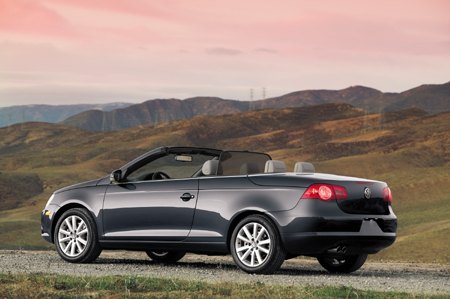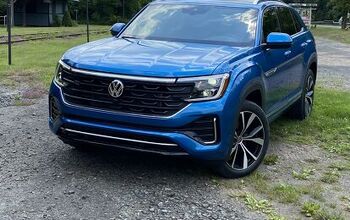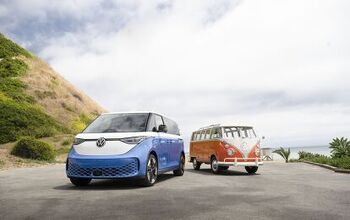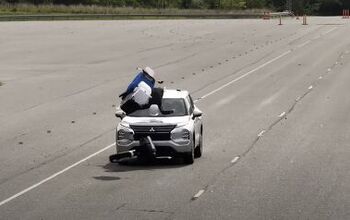Volkswagen Eos Review
There is no way to overstate the appeal of the new Volkswagen Eos’ folding hardtop. I sat inside the car for ten minutes, opening and closing the lid, marveling at the mechanism’s precision and design. What kind of mind can develop something that folds and unfolds with such infinite grace? If you like to visit high speed factories spitting out hundreds of widgets per minute, filling them with liquids and shrink wrapping them in three swift motions, then you will never tire of lowering and raising the Eos’ five-piece hardtop. As for the rest of Vee Dub’s CSC (coupe-sunroof-convertible), it’s danger, boredom ahead.
All the time, effort and money VW’s engineers spent creating and manufacturing the Eos’ hardtop must have been scrimped from the company’s design department. Although there’s plenty of concave and convex “flame surfacing” in the usual places (wheel arches, door bottoms), there’s nothing even mildly warm about the Eos’ overall look. While the detailing takes German minimalism to the next level (dull and insipid), the proportions are the real passion killer. The overhangs are grossly mismatched, the ascending beltline says “tip-toeing bathtub” and the rearwards sloping rear deck is just plain wrong. At best (i.e. after you buy one), the Eos is “cute.” For those of us who remain on the sidelines, "homely and unlovable" is closer to the truth.
As befits a car that was shown as a concept just 18 months ago, the Eos’ interior is a parts bin special. Although the fascia is all new, all the bits slotted in are standard Golf fare— and none the worse for it. It’s a clean look with faultless ergonomics, from cosseting chairs to simple controls. Our tester’s Sport package (about $3500) adds some much needed spizzarkle– aluminum trim and wikkid dials– to the cabin’s otherwise dour demeanor. There aren’t a lot of high tech toys, but the [optional] satellite radio gets channeled through an [optional] mini Marshall stack and the [optional] corner steering xenon lighting makes drivers feel positively Lexian.
Pistonheads note: the folding hardtop VW Eos is no one trick pony. Provided you stump-up for VW’s dual shift gearbox (DSG), it’s a one-and-a-half trick pony. The superb paddle shift system, which has transformed ugly ducklings like the VW GTI and Audi A3 into F1 soaring Eagles, turns the Eos into a runt swan. Credit the extra weight of the hardtop top, its motor and the chassis strengthening needed to maintain torsional rigidity. It does nothing for the car’s dynamics, except spoil them.
VW’s press site pegs the Eos’ curb weight at 3503 lbs. That would make the Eos (which sits on a modified Passat platform) just 195 pounds heavier than a GTI. It feels three times that. Even under full throttle, the DSG labors to make anything happen. The razor-sharp small VW driving experience is decidedly dumbed down. Our tester had the base engine: a 2.0-liter, 200hp, turbocharged four. This mill, so willing and frisky in all the other VW/Audi executions, feels overwhelmed and peaky in this application. If you want to buy this top– I mean car, wait for September, when the factory starts building the Eos with a 250hp V6.
Of course, the Eos’ ponderousness steals more than the accelerative joy normally derived from this engine and transmission combination. The “I can’t believe this is a front driver” handling experience from the GTI is lost as well. Understeer is the party guest from Hell, arriving early and staying late. The props top also seems to unbalance the equation vertically; the Eos navigates curves like an ungainly and top heavy SUV. In addition to the nautical motions, you also get a maritime soundtrack: the top creaks and groans over rough patches like an old wooden schooner.
If the Jetta is all grown up, the Eos is an octogenarian. Its lethargic performance and high quality materials highlight the blue rinse effect. The pricing punctuates these observations. The 2.0-liter Eos starts under $30k, and quickly ascends in the high 30’s. The 3.2 will easily break $40k. Hardtop or no, the GTI is looking more and more like the pick of the litter.
Anyway, the Eos is clearly another “lifestyle” Volkswagen aimed at the empty nest/trustafarian market. While the Eos’ retractable hardtop is nothing new from the likes of the Mercedes (SL/SLK), we’re grateful that the new Vee Dub brings Germany's open and shut case to the masses. If Wolfsburg had attached their wundertop to a more attractive package, they would have had an instant classic. Instead, they’ve built a highly polished though dynamically dull machine whose appeal— and sales— will rely almost entirely on the novelty of its hood. Will that party trick be enough to move the metal? Absolutely.
More by Jay Shoemaker
Latest Car Reviews
Read moreLatest Product Reviews
Read moreRecent Comments
- Kmars2009 I rented one last fall while visiting Ohio. Not a bad car...but not a great car either. I think it needs a new version. But CUVs are King... unfortunately!
- Ajla Remember when Cadillac introduced an entirely new V8 and proceeded to install it in only 800 cars before cancelling everything?
- Bouzouki Cadillac (aka GM!!) made so many mistakes over the past 40 years, right up to today, one could make a MBA course of it. Others have alluded to them, there is not enough room for me to recite them in a flowing, cohesive manner.Cadillac today is literally a tarted-up Chevrolet. They are nice cars, and the "aura" of the Cadillac name still works on several (mostly female) consumers who are not car enthusiasts.The CT4 and CT5 offer superlative ride and handling, and even performance--but, it is wrapped in sheet metal that (at least I think) looks awful, with (still) sub-par interiors. They are niche cars. They are the last gasp of the Alpha platform--which I have been told by people close to it, was meant to be a Pontiac "BMW 3-series". The bankruptcy killed Pontiac, but the Alpha had been mostly engineered, so it was "Cadillac-ized" with the new "edgy" CTS styling.Most Cadillacs sold are crossovers. The most profitable "Cadillac" is the Escalade (note that GM never jack up the name on THAT!).The question posed here is rather irrelevant. NO ONE has "a blank check", because GM (any company or corporation) does not have bottomless resources.Better styling, and superlative "performance" (by that, I mean being among the best in noise, harshness, handling, performance, reliablity, quality) would cost a lot of money.Post-bankruptcy GM actually tried. No one here mentioned GM's effort to do just that: the "Omega" platform, aka CT6.The (horribly misnamed) CT6 was actually a credible Mercedes/Lexus competitor. I'm sure it cost GM a fortune to develop (the platform was unique, not shared with any other car. The top-of-the-line ORIGINAL Blackwing V8 was also unique, expensive, and ultimately...very few were sold. All of this is a LOT of money).I used to know the sales numbers, and my sense was the CT6 sold about HALF the units GM projected. More importantly, it sold about half to two thirds the volume of the S-Class (which cost a lot more in 201x)Many of your fixed cost are predicated on volume. One way to improve your business case (if the right people want to get the Green Light) is to inflate your projected volumes. This lowers the unit cost for seats, mufflers, control arms, etc, and makes the vehicle more profitable--on paper.Suppliers tool up to make the number of parts the carmaker projects. However, if the volume is less than expected, the automaker has to make up the difference.So, unfortunately, not only was the CT6 an expensive car to build, but Cadillac's weak "brand equity" limited how much GM could charge (and these were still pricey cars in 2016-18, a "base" car was ).Other than the name, the "Omega" could have marked the starting point for Cadillac to once again be the standard of the world. Other than the awful name (Fleetwood, Elegante, Paramount, even ParAMOUR would be better), and offering the basest car with a FOUR cylinder turbo on the base car (incredibly moronic!), it was very good car and a CREDIBLE Mercedes S-Class/Lexus LS400 alternative. While I cannot know if the novel aluminum body was worth the cost (very expensive and complex to build), the bragging rights were legit--a LARGE car that was lighter, but had good body rigidity. No surprise, the interior was not the best, but the gap with the big boys was as close as GM has done in the luxury sphere.Mary Barra decided that profits today and tomorrow were more important than gambling on profits in 2025 and later. Having sunk a TON of money, and even done a mid-cycle enhancement, complete with the new Blackwing engine (which copied BMW with the twin turbos nestled in the "V"!), in fall 2018 GM announced it was discontinuing the car, and closing the assembly plant it was built in. (And so you know, building different platforms on the same line is very challenging and considerably less efficient in terms of capital and labor costs than the same platform, or better yet, the same model).So now, GM is anticipating that, as the car market "goes electric" (if you can call it that--more like the Federal Government and EU and even China PUSHING electric cars), they can make electric Cadillacs that are "prestige". The Cadillac Celestique is the opening salvo--$340,000. We will see how it works out.
- Lynn Joiner Lynn JoinerJust put 2,000 miles on a Chevy Malibu rental from Budget, touring around AZ, UT, CO for a month. Ran fine, no problems at all, little 1.7L 4-cylinder just sipped fuel, and the trunk held our large suitcases easily. Yeah, I hated looking up at all the huge FWD trucks blowing by, but the Malibu easily kept up on the 80 mph Interstate in Utah. I expect a new one would be about a third the cost of the big guys. It won't tow your horse trailer, but it'll get you to the store. Why kill it?
- Lynn Joiner Just put 2,000 miles on a Chevy Malibu rental from Budget, touring around AZ, UT, CO for a month. Ran fine, no problems at all, little 1.7L 4-cylinder just sipped fuel, and the trunk held our large suitcases easily. Yeah, I hated looking up at all the huge FWD trucks blowing by, but the Malibu easily kept up on the 80 mph Interstate in Utah. I expect a new one would be about a third the cost of the big guys. It won't tow your horse trailer, but it'll get you to the store. Why kill it?





































Comments
Join the conversation
I'd been planning to drive one of these. But when I went to the dealer a few weeks ago, I had to choose between a manual GTI and DSG GLI. I'd already driven a manual GLI, so I went with the DSG car. Has anyone driven both the GLI and GTI? Do they feel any different?
I checked this site in the hopes of useful reviews in search of a new car. What I feel I found is a site organized by a group of testosterone driven teens. The language is trite with pre-packaged phrases, competition for sarcasm the rule. "My dog is better than your dog" disguised as a review. Those who can dig through the "review?" searching for some insight best not question it lest they be driven back by insults. I thought I was on CNet where juveniles argue over who's cell phones or mp3 players "rule". Nothing I found useful.